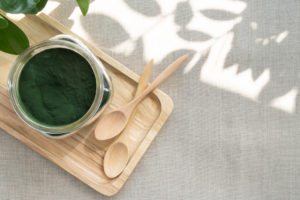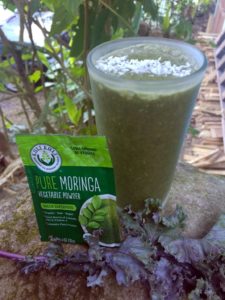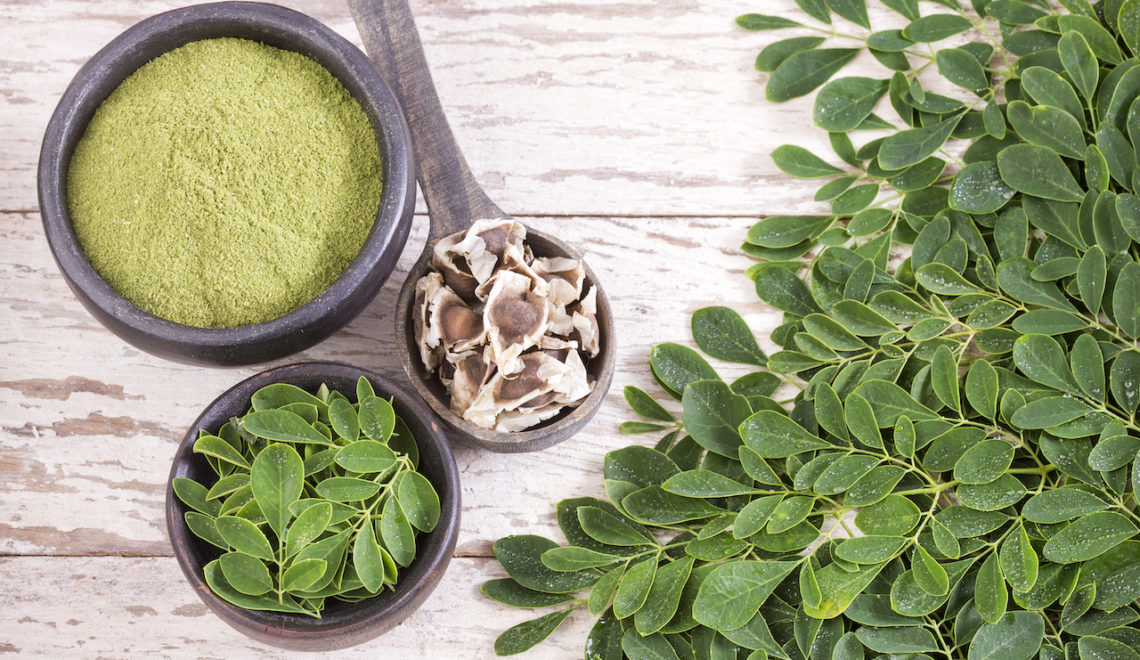Why not combine two superfoods into one delicious protein-rich smoothie? Moringa leaves come from a plant often called “the miracle tree” and has been used as a superfood for thousands of years. Spirulina, a blue-green algae, is found in fresh water sources, and has been used as a food source since the 9th century in Chad, Africa.
Spirulina is recorded in use by the Aztecs in 16th century Mexico and found in lakes in France. The first factory large-scale production of this ancient food started in the 1970s. Today, it is dried into cakes called “dihe” and sold in local markets for making broths and meals.
Why Eat Spirulina?
Why consume this mysterious, dark green organism and what are some smoothie tips? We’ll summarize a few reasons below and then go into a smoothie recipe with a twist. We also wrote a fun article about a Battle of the Supergreens, reviewing the nutritional content of spirulina vs. moringa.
Both of these supergreens are full of nutrients.
1) Spirulina is Packed with Protein
A well-known superfood, spirulina is actually a cynobacteria. That is, a bacteria with non-nucleus bound genetic material. It has chlorophyll and uses the sun as an energy source.
By weight, it is 50-70 percent protein. Compare that to red-meat at 27 percent and lentils at 12 percent. Spirulina also contains 10 of the 12 essential amino acids. These proteins are highly digestible and don’t require heat to be bioavailable thanks to its simple cell structure.
Since spirulina grows rampantly and is high-heat tolerant, it is being studied and used around the world as a sustainable source of nutrition for malnourished populations in Africa and Southeast Asia. It can also be harvested year-round and requires 10 times less water than other vegetables.
2) Spirulina is A Nutrient Dense Superfood
Spirulina is packed with phytonutrients, including vitamins A, B 2, 6, 8, and 12, and K, iodine, minerals like calcium and iron, gamma-linolenic acid, essential fatty acids, phytopigments, 18 different amino acids, and carbohydrates.
Some of the studied benefits include reducing blood lipid profile, blood sugar, body weight, and would healing time. For this reason, spirulina is reputed with these health benefits:
- Treating type 2 diabetes
- Reducing hypertension and cardiovascular disease
- Reduce allergic reactions
- Boost immune-system
- Fight candida bacteria
- Protection against viruses, such as influenza and HIV
- Treating anemia
- Anti-inflammatory
- Reverse effects of arsenic poisoning
A note of caution – depending on the source, spirulina can contain toxic substances and heavy metals. Always purchase spirulina from a trusted source with verified heavy metal testing and safe sourcing.
3) Spirulina Has Probiotic Power
In studies, spirulina is found to stimulate the growth of lactic acid bacteria. This bacteria, also found naturally in your intestines, helps with everything from digestion to nutrient absorption. Read more about probiotics and why probiotics can control your weight and mental health.
At this point, you’re likely familiar with moringa as a superfood. We cover the Top 10 Reasons to Eat Moringa Everyday in this article, if you feel like further reading on the topic.
Otherwise, we’ll get straight to the smoothie!
Moringa Spirulina Smoothie Recipe
Spirulina is readily available in pills that can be taken as a supplement. But if you want to incorporate spirulina to your food, it’s a great addition, in powder form, to smoothies, salad dressings, and juice.
Because of its strong flavor, it’s recommended to be paired with sweet fruits and other healthy greens, like moringa.
Ingredients:
Instructions:Add all of the ingredients to a blender and blend until smooth & creamy. Like most smoothie recipes, you will need to adjust according to your preference. For example, add more liquid for a lighter smoothie. Or add more nut butter or yogurt for a thicker smoothie for a texture closer to ice cream. |
Since spirulina is a power detoxifying agent and can have a strong flavor, start small and work more spirulina into your diet each day. If you’re new to the world of smoothies, you’re in for an extra treat. Smoothies can be a great way to start your day, help children get their daily greens, and offer an afternoon boost.
This summer 2020, we also have a moringa smoothie giveaway happening! Here’s a quick reminder of how to enter. We can’t wait to see your creations!
・・・
1. Post a photo of your delicious Moringa Smoothie
2. Tag @kulikulifoods
3. Use the hashtag #MyMoringaSmoothie
・・・
We cover 4 Tips to Make a Healthy Moringa Smoothie too, for additional inspiration. As part of our probiotic recipe series, we also have other delicious #moringainspired probiotic recipes.
There you have it! All the tips and tricks to make the perfect healthy smoothie. What’s your perfect spirulina moringa recipe? Let us know in the comments!
Don’t forget to tag @kulikulifoods in any social media posts you share so we can see your beautiful creations!












